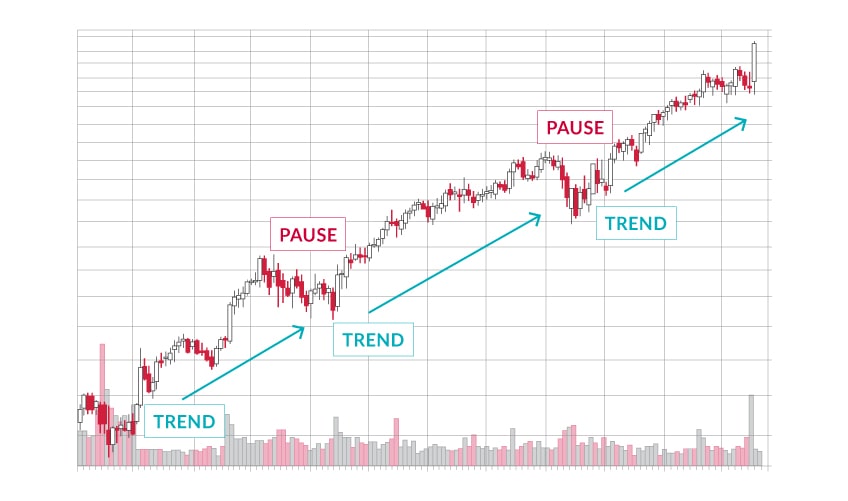Day trading is the practice of buying and selling a financial asset within a single trading day. Known as day traders, investors that follow this practice usually make use of high levels of financial leverage to maximise the profit they can earn from small market movements. Day trading is most commonly seen in the foreign exchange and stock markets.
How to Day Trade
Due to the short time frame involved and the use of high levels of leverage to maximise profits, day trading is normally reserved for experienced investors that are knowledgeable about the financial markets. To be successful, an investor must develop a clear strategy and have enough discipline to stick to it.
Day traders focus their activity on only a few assets, opening their positions on the market throughout a trading day and closing them before it ends. Following the latest economic news and events is of utmost importance to a day trader, as it helps paint a picture of how a specific asset will perform over the coming day, allowing them to adjust their strategy accordingly.

Technical analysis is also central to carrying out a successful day trading strategy. Using a variety of indicators, investors can analyse the markets and develop an idea of how a given asset may move, how strong that movement may be and how long it could last. Combining technical and fundamental analysis gives experienced investors an edge over others when day trading in the financial markets.
The use of high levels of leverage is also key to many day trading strategies, as this enables investors to control larger positions on the market with a smaller initial investment. As the price movements can often be small, leverage helps investors maximise the profit they can make in a single day. This is another reason why day trading is often conducted by experienced investors, as the use of financial leverage can be risky, and requires a thorough understanding of the markets and an adequate strategy to manage the risks involved.
Day Trading Strategies
There are various day trading strategies that investors can follow including:
Trend Trading

Trend trading involves studying the price chart of an asset at a longer time frame to identify the prevailing market trend. Once it has been identified, an investor will revert to a smaller time frame on the same price chart and look for trading opportunities that follow the overall trend. For example, if the EUR/USD currency pair is trending upwards on the 4-hour time frame, then an investor can switch to a 15-minute time frame and look for opportunities to go long on the pair.
Counter Trend Trading
Similar to trend trading, this day trading strategy involves identifying a prevailing market trend at a longer time frame and then looking for opportunities to place trades in the opposite direction at a shorter time frame. The impetus for this is to attempt to identify the end of a market trend and profit from the reversal. This is a riskier strategy but can lead to greater profits. For example, if Apple shares are in an upward trend that seems to be slowing on the 4-hour time frame, an investor can look for opportunities to short the stock on the 15-minute time frame to benefit from a potential reversal.
Breakout Trading
Breakout trading involves identifying when an asset has been in a period of consolidation, in other words, trading in a range between support and resistance lines that have been holding strong. An investor will then place trades on either side of the range, in the hopes that the asset will breakout and form a new trend. This day trading strategy is usually more effective when an asset’s price has been trading in a very tight range. Investors should target profits equal to the number of pips that had made up the earlier trading range.
The Problems with Day Trading
There are a number of factors that affect the potential profitability of a day trading approach which investors should take into consideration before proceeding with such a strategy.
Required Capital
Being undercapitalised is one of the main reasons traders struggle to succeed in the market. A trading account must be sufficiently funded to guarantee an investor’s open positions in the case of market volatility. This is even more important when it comes to day trading, where positions are left open throughout a trading day. Additionally, the use of high leverage with an undercapitalised account can lead to added risks, including the loss of all invested capital.
Transaction Costs

As day trading can involve opening and closing a number of trades within a single day, transaction costs for each trade must be taken into account when formulating a strategy. Both spreads and commissions are calculated on a per trade basis, meaning that the more trades an investor makes, the more costs they will accrue. Thus, a successful day trading strategy must be one where an investor is able to earn enough from trades throughout the day to both cover the costs involved and still make a profit.
Trading Psychology

Trading psychology is of utmost importance when it comes to investing in the financial markets. In the case of day trading, there are added pressures to consider as large trades must be placed quickly and monitored throughout the day. As such, being successful requires a great deal of preparation and determination, as well as a sound risk management strategy to protect investors against potential market volatility.
 Change Language ▼
Change Language ▼

